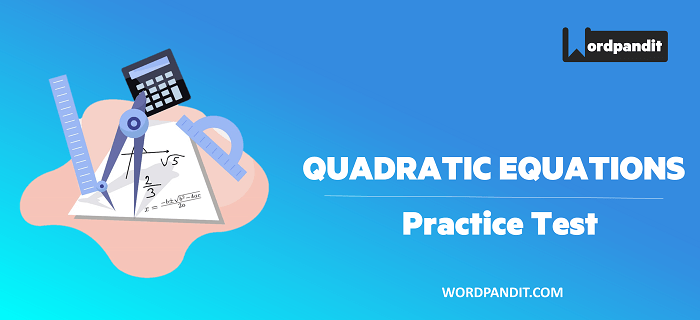- This is an assessment test.
- To draw maximum benefit, study the concepts for the topic concerned.
- Kindly take the tests in this series with a pre-defined schedule.
Algebra: Quadratic Equations Test-4
Congratulations - you have completed Algebra: Quadratic Equations Test-4.You scored %%SCORE%% out of %%TOTAL%%.You correct answer percentage: %%PERCENTAGE%% .Your performance has been rated as %%RATING%%
Your answers are highlighted below.
Question 1 |
The expression $ \displaystyle {{x}^{4}}-2{{x}^{2}}+k$
will be a perfect square
when the value of K is
will be a perfect square
when the value of K is
2 | |
1 | |
−1 | |
−2 |
Question 1 Explanation:
$ \begin{array}{l}{{x}^{4}}-2{{x}^{2}}+k\\={{x}^{4}}-2{{x}^{2}}+1+k-1\\={{({{x}^{2}}-1)}^{2}}+k-1\\If\,k=1\,\text{then}\,\text{the}\,\text{term}\,\text{will}\,\text{be}\,\text{a}\,\text{perfect}\,\text{square}\text{.}\end{array}$
Question 2 |
if p−2q=4, then the value of p3−8q3−24pq−64 is:
2 | |
0 | |
3 | |
-1 |
Question 2 Explanation:
$ \displaystyle \begin{array}{l}p-2q=4\\Cubing\,both\,sides,\\=>{{(p-2q)}^{3}}={{4}^{3}}\\=>{{p}^{3}}-3.{{p}^{2}}.2q+3.p.4{{q}^{2}}-8{{q}^{3}}=64\\=>{{p}^{3}}-6pq(p-2q)-8{{q}^{3}}=64\\=>{{p}^{3}}-24pq-8{{q}^{3}}-64=0\end{array}$
Question 3 |
If the expression x2 +x +1 is<br>written in the form $\displaystyle {{\left( x+\frac{1}{2} \right)}^{2}}+{{q}^{2}}$<br>then the possible values of q are
$ \displaystyle \pm \frac{1}{3}$ | |
$ \displaystyle \pm \frac{\sqrt{3}}{2}$ | |
$ \displaystyle \pm \frac{2}{\sqrt{3}}$ | |
$ \displaystyle \pm \frac{1}{2}$ |
Question 3 Explanation:
$ \displaystyle \begin{array}{l}{{\left( x+\frac{1}{2} \right)}^{2}}+{{q}^{2}}={{x}^{2}}+x+1\\=>{{x}^{2}}+\frac{1}{4}+x+{{q}^{2}}={{x}^{2}}+x+1\\=>{{q}^{2}}=\frac{3}{4}\\=>q=\pm \sqrt{\frac{3}{4}}=\pm \frac{1}{2}\sqrt{3}\end{array}$
Question 4 |
$ \displaystyle {{a}^{2}}-2a-1=0$
then value of $ \displaystyle {{a}^{2}}+\frac{1}{{{a}^{2}}}+3a-\frac{3}{a}$ is
then value of $ \displaystyle {{a}^{2}}+\frac{1}{{{a}^{2}}}+3a-\frac{3}{a}$ is
25 | |
30 | |
35 | |
40 |
Question 4 Explanation:
$ \displaystyle \begin{array}{l}{{a}^{2}}-2a-1=0\\{{a}^{2}}-1=2a\\on\,dividing\,with\,a\\a-\frac{1}{a}=2\\Now\,\,{{a}^{2}}+\frac{1}{{{a}^{2}}}+3a-\frac{3}{a}\\{{\left( a-\frac{1}{a} \right)}^{2}}+2+3\left( a-\frac{1}{a} \right)\\4+2+3(2)\\4+2+6=12\end{array}$
Question 5 |
If a2 +1=a, then the value of a12 +a6 +1 is:
-3 | |
1 | |
2 | |
3 |
Question 5 Explanation:
\[\begin{align}
& {{a}^{2}}+1=a \\
& =>{{a}^{2}}-a+1=0 \\
& Multiply\,both\,sides\,by\,(a+1), \\
& =>(a+1)({{a}^{2}}-a+1)=0 \\
& =>{{a}^{3}}+1=0 \\
& =>{{a}^{3}}=\,-1 \\
& Thus, \\
& {{a}^{12}}+{{a}^{6}}+1=1+1+1=3 \\
& \\
& Alternate\,solution \\
& {{a}^{2}}+1=a \\
& Cubing\,both\,sides \\
& =>{{a}^{6}}\,+\,1+\,3{{a}^{2}}\,({{a}^{2}}\,+\,1)\,=\,{{a}^{3}} \\
& =>{{a}^{6}}\,+\,1+\,3{{a}^{2}}\,(a)\,=\,{{a}^{3}}\,\,(initial\,condition\,used) \\
& =>{{a}^{6}}\,+\,1+\,3{{a}^{3}}\,=\,{{a}^{3}} \\
& =>{{a}^{6}}\,+\,1+\,2{{a}^{3}}\,\,=\,0 \\
& =>\,\,{{({{a}^{3}}\,+\,1)}^{2}}\,=\,0 \\
& =>\,\,{{a}^{3}}\,\,=\,-1 \\
\end{align}\]
Using this, we can find the value of the expression.
Remember, in this case, only one real root (a=-1) exists whereas the other two roots are imaginary in nature.
Once you are finished, click the button below. Any items you have not completed will be marked incorrect.
There are 5 questions to complete.
List |












Question 5 Explanation: a2+1=aCubingbothsides,=>a2−a+1=0=>(a+1)(a2−a+1)=0=>a3+1=0=>a=−1−−−√3Thusa12+a6+1=1+1+1=3
This is wrong..
U multiplied by (a+1) and this expression is getting 0 at a=-1, and u have assumed this as solution for quadratic equation.
Actual solution for quadratic equation is +-i.
So answer is -3 for this solution.